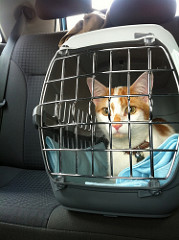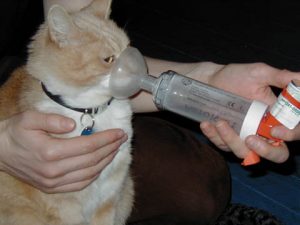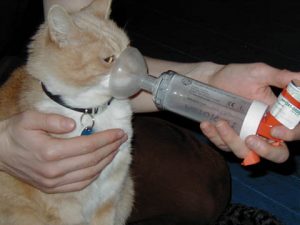Few things are more rewarding than ushering our beloved pets into their senior years, helping them experience senescence with grace, comfort, and plenty of love. Unfortunately, few things also cause such anxiety (both financial and emotional). An elderly pet is more likely to have multiple medical issues, as they experience the “old-age” diseases that are more common with a longer life span – such as kidney disease, hyperthyroidism, heart disease, and cancer.
Successful treatment or management of these illness is dependent on a few things – first, the pet owner’s awareness of the problem; second, their willingness to treat the condition. As someone who works routinely with pet owners in my capacity as a cat behavior consultant, I am often surprised at how poorly many cat owners perform on both fronts.

Cats are experts at hiding pain, but I’ve seen situations where cat owners didn’t seem to think much of a limp, a tooth that was falling out, or sudden changes in their cat’s behavior that suggested pain or discomfort. In some cases, this was due to a lack of attention, or the owner’s lack of comfort with examining all parts of their cat’s body. In other cases, I think it was a case of pretending the problem didn’t exist. In most cases, when I brought up a vet exam, I could see the dread growing across the human’s face…the stress of getting their cat into a carrier, the pathetic meowing during the car ride, the perception of the cat as “difficult” during the vet visit, the mounting veterinary bills that would likely result. Often owners cite their own distaste for going to the doctor as a good reason not to bring a sick cat to the veterinarian. And of course many owners don’t even bring their cats for a yearly preventative physical, which is a great way to catch and treat some of those medical conditions before they become bigger problems.
But even more surprising to me were the owners who had already gone through the diagnosis stage, gotten the pills or other medication from their vet, but had quickly given up on actually administering the medication to their cat. When I asked clients if their cat was under any medical treatment, they might rummage in a drawer or the back of the medicine cabinet, and return with a full bottle (covered in dust bunnies) of pills…”oh, he’s too difficult to get a pill into…”…”I tried to pill him but it just stresses him out so much…”…”I just feel so bad…” – I’ll bet not as badly as the cat who needs medical treatment!
Turns out that owner compliance when it comes to pet meds isn’t great. Several studies have been done on dog owners, including using special pill bottles that electronically monitor when and how often medication is administered. Most owners over-estimated how much of the medication they gave their dog, and often did not give doses at the recommended time frames. In one study, only 34% of antibiotic doses were given at correct intervals (Barter & Watson, 1996). Thirty-eight percent of owners of dogs with periodontal disease stopped brushing their dog’s teeth, even though daily brushing was recommended. What seemed to help: the time the veterinarian spent with the owner, and whether the pills needed to be administered one to two times a day (more compliance) versus three times a day (less compliance). We have little data on cat owner compliance when it comes to meds, but I’d bet (and I’m not much of a gambler) that it’s even less than dog owners.
[snap url=”https://www.psychologytoday.com/blog/animal-emotions/201602/whats-good-life-old-dog” alt=”My Thumbnail” ]
Not knowing how dire these stats were, I was a bit surprised earlier this year when I read a blog post from Marc Bekoff (whose posts I usually quite enjoy!), suggesting that it was better to let his dog enjoy his old age (with a gastrointestinal disease) than give his dog a “nasty pill.” He opted instead to give his dog ice cream and skipped the meds. As Bekoff commonly writes about animal welfare, I was saddened by his description of treating an elderly pet as something invasive and stressful, rather than a gift to both the owner and pet – the gift of a longer life with less discomfort.
Now let me be clear, I’m not one of those people who advocates letting an elderly pet suffer just for the sake of hanging on and not being ready to say goodbye. But what bothered me about Bekoff’s post was that it contained logical fallacies. He posited the situation as a choice between a “nasty pill” and ice cream, a false dichotomy. My question: why not both the pill and the treat? As any animal behaviorist should be aware, the use of positive reinforcement training has been established for captive animals (including zoo animals and pets) to make husbandry and care (including medications and blood draws) low/no-stress (see here for some great videos from my dear friend and fellow cat behavior consultant Ingrid Johnson on how to make medications a positive experience).
 I had a beloved cat who became asthmatic when he was older. I opted to treat him with an inhaler, which involved training him to sit still with a mask over his face while he breathed in the medication. When I started, did I believe he was going to accept this without coersion? No way. But when he got his favorite treat (chicken baby food) with every treatment, before long he was trotting over for his medication and would sit still for a full 45 seconds of breathing in the meds. By pairing the “ice cream” with the “nasty pill”, I was able to get no-stress compliance from my cat, and he got the medications he needed to breathe easy.
I had a beloved cat who became asthmatic when he was older. I opted to treat him with an inhaler, which involved training him to sit still with a mask over his face while he breathed in the medication. When I started, did I believe he was going to accept this without coersion? No way. But when he got his favorite treat (chicken baby food) with every treatment, before long he was trotting over for his medication and would sit still for a full 45 seconds of breathing in the meds. By pairing the “ice cream” with the “nasty pill”, I was able to get no-stress compliance from my cat, and he got the medications he needed to breathe easy.
The other thing I found bothersome about the Bekoff piece was that he used selectively emotional language. The pills were “awful” and “nasty,” and they had to be “shoved” down the dog’s throat. The picture this creates in one’s mind is of course, that the dog is being tortured, and that Bekoff is absolutely right to stop treatment.
So what if there’s a better way? There absolutely is. See, it doesn’t have to be about quality OR quantity, and although I agree that quality should always take precedence, you can get more quantity WITH quality if you have the tools you need. So where do you get those tools?
 I’m always so happy when life places another amazing person in my path! A few months ago, Dr. Kris Chandroo reached out to me in response to a blog post I wrote about Feliway. That is when I first heard of his AMAZING website iwillhelpyourcat.com. I was immediately really excited about the fact that he was a veterinarian, focused on feline behavior and welfare, and that Kris recognized that client compliance is a special issue for cats. He also wrote a great blog post on the topic of medicating older cats who may not want a pill, which you can read here.
I’m always so happy when life places another amazing person in my path! A few months ago, Dr. Kris Chandroo reached out to me in response to a blog post I wrote about Feliway. That is when I first heard of his AMAZING website iwillhelpyourcat.com. I was immediately really excited about the fact that he was a veterinarian, focused on feline behavior and welfare, and that Kris recognized that client compliance is a special issue for cats. He also wrote a great blog post on the topic of medicating older cats who may not want a pill, which you can read here.
So my next blog post (later this week) will feature an interview/chat with Kris and a focus on his new project, Stress to Success – your step by step guide on how to medicate cats, even the tough ones! So stay tuned – we’ll talk about enrichment, veterinarian-client relationships, the Bekoff piece, and of course about Stress to Success!
References on compliance
Adams, V. J., Campbell, J. R., Waldner, C. L., Dowling, P. M., & Shmon, C. L. (2005). Evaluation of client compliance with short-term administration of antimicrobials to dogs. Journal of the American Veterinary Medical Association, 226(4), 567-574.
Barter, L. S., Maddison, J. E., & Watson, A. D. J. (1996). Comparison of methods to assess dog owners’ therapeutic compliance. Australi-n veterinary journal, 74(6), 443-446.
Barter, L. S., Watson, A. D. J., & Maddison, J. E. (1996). Owner compliance with short term antimicrobial medication in dogs. Australi-n veterinary journal, 74(4), 277-280.
Grave, K., & Tanem, H. (1999). Compliance with short‐term oral antibacterial drug treatment in dogs. Journal of Small Animal Practice, 40(4), 158-162.
Miller, B. R., & Harvey, C. E. (1994). Compliance with oral hygiene recommendations following periodontal treatment in client-owned dogs.Journal of veterinary dentistry, 11(1), 18-19.



